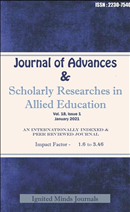Difference in Speed and Agility between Native and Non-Native Athletes: A Comparative study of Physical Performance
DOI:
https://doi.org/10.29070/zq1n5019Keywords:
Native games, Non- Native games, Bio-motor abilities, Speed, AgilityAbstract
This study aimed to examine and compare the speed and agility levels between athletes participating in Native and Non- Native sports. Forty male athletes were selected, comprising twenty Native Kho-Kho players and twenty Non- Native Hockey players, all of whom competed at various levels, including subdivision, district, and state competitions. The participants, aged between 14 and 16 years, were exclusively male. The analysis revealed differences in the average motor performance between the two groups. Specifically, Non- Native players exhibited lower levels of speed and agility compared to their Native counterparts. A t-test was conducted to statistically compare the motor performance between Native and Non- Native athletes, revealing no significant differences in speed (p = 0.77) or agility (p = 1.23) between the groups. Consequently, the study concluded that there were no statistically significant differences in motor performance variables between Native and Non- Native players. These findings highlight the need for future research to develop strategies to enhance motor performance in athletes from these specific populations.
Downloads
References
Bangsbo, J. (1994). Fitness training in football – A scientific approach. August Krogh Institute.
Bangsbo, J., Norregaard, L., & Thorsoe, F. (1991). Activity profile of competition soccer. Canadian Journal of Sport Sciences, 16(2), 110-116.
Clarke, H. E. (1959). Application of measurement to health and physical education. Englewood Cliffs, NJ: Prentice-Hall.
Cooper, S. M., Baker, J. S., Tong, R. J., Roberts, E., & Hanford, M. (2005). The repeatability and criterion related validity of the 20 m multistage fitness test as a predictor of maximal oxygen uptake in active young men. British Journal of Sports Medicine, 39(4), e19. https://doi.org/10.1136/bjsm.2004.013078
Duncan, M. J., Lyons, M., & Nevill, A. M. (2008). Evaluation of peak power prediction equations in male basketball players. Journal of Strength and Conditioning Research, 22(4), 1379-1381. https://doi.org/10.1519/JSC.0b013e3181739e5e
Franks, A., Williams, A. M., Reilly, T., & Nevill, A. (1999). Talent identification in elite youth soccer players: Physical and physiological characteristics. Journal of Sports Sciences, 17(9), 812. https://doi.org/10.1080/026404199365769
Gil, S. M., Gil, J., Ruiz, F., Irazusta, A., & Irazusta, J. (2007). Physiological and anthropometric characteristics of young soccer players according to their playing position: Relevance for the selection process. Journal of Strength and Conditioning Research, 21(2), 438-445. https://doi.org/10.1519/R-19995.1
Gravina, L., Gil, S. M., Ruiz, F., Zubero, J., Gil, J., & Irazusta, J. (2008). Anthropometric and physiological differences between first team and reserve soccer players aged 10-14 years at the beginning and end of the season. Journal of Strength and Conditioning Research, 22(4), 1308-1314. https://doi.org/10.1519/JSC.0b013e3181739e5e
Harman, E. A., Rosenstein, M. T., Frykman, P. N., & Rosenstein, R. M. (1990). The effects of arms and countermovement on vertical jumping. Medicine and Science in Sports and Exercise, 22(6), 825-833.
Hockey, R. V. (1993). Physical activity and health: An epidemiologic study of an entire community. American Journal of Public Health, 83(2), 201-204.
Kalapotharakos, V. I., Ziogas, G. G., Tokmakidis, S. P., & Dellas, S. E. (2006). Physiological characteristics of elite and sub-elite soccer players. Journal of Sports Medicine and Physical Fitness, 46(4), 510-516.
Kannan, S. (2011, July 11). Messi boost as Indian Hockey challenges cricket. BBC News. https://www.bbc.co.uk/news/world-asia-india-14160319
le Gall, F., Carling, C., Williams, M., & Reilly, T. (2010). Anthropometric and fitness characteristics of international, professional and amateur male graduate soccer players from an elite youth academy. Journal of Science and Medicine in Sport, 13(1), 90-95. https://doi.org/10.1016/j.jsams.2008.07.013
Mohr, M., Krustrup, P., & Bangsbo, J. (2003). Match performance of high-standard soccer players with special reference to development of fatigue. Journal of Sports Sciences, 21(7), 519-528. https://doi.org/10.1080/0264041031000071182
Rampinini, E., Coutts, A. J., Castagna, C., Sassi, R., & Impellizzeri, F. M. (2009). Variation in top level soccer match performance. International Journal of Sports Medicine, 30(5), 367-373. https://doi.org/10.1055/s-0028-1105930
Rienzi, E., Drust, B., Reilly, T., Carter, J. E., & Martin, A. (2000). Investigation of anthropometric and work-rate profiles of elite South American international soccer players. Journal of Sports Medicine and Physical Fitness, 40(2), 162-169.
Wilson, B. (2012, February 15). Hockey looks to score in India. BBC News. https://www.bbc.co.uk/news/business-18199585











